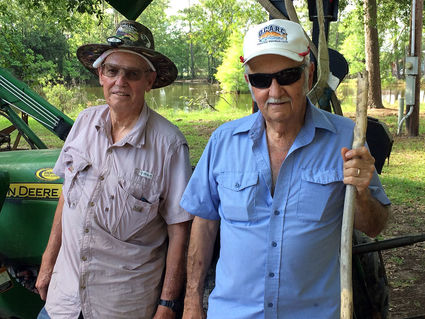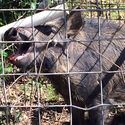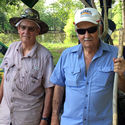Trappers fight off cloven-hoofed invaders
Last updated 5/14/2019 at Noon
Photo: Orange neighbor's Gerald Burleigh and Don Hubbard work together to trap feral hogs in Orange County. Record Photo: Dave Rogers
Dave Rogers
For The Record
Orange neighbor's Gerald Burleigh and Don Hubbard have been friends since childhood.
“We raised dogs together. We’ve been hunting and fishing partners for as long as we can remember,” said Burleigh.
An association with guns seems natural since Hubbard spent 22 years as a deputy constable in Orange County and Burleigh was a U.S. Navy River Rat during the Vietnam War.
His crew engaged in many running gun battles as it patrolled the dangerous rivers in a long, narrow boat that came complete with a 105-mm howitzer and a flamethrower.
But that was then. The two men have a new pastime now.
They trap wild hogs.
Properly known as feral hogs, they’re a nuisance causing millions of dollars in damage in Texas each year. The Smithsonian Institute calls them “a plague of pigs.”
“They’ll run your deer off your feeders. They’ll tear up your yards and gardens, digging for grubs,” Burleigh said.
“Anything they’ll get, they’ll eat it. They kill fawns, quail, calves. They’re moving into the city now.
“But I like to eat pork.”
Hogs have run wild in Texas for more than 300 years, first brought here by the Spanish. In the 20th century, Russian “boar” hogs were introduced to Texas for game hunting.
They got loose. They intermingled. It was hogs gone wild.
Today, the animals’ wild descendants number from 1.5 million to 2 million in the state of Texas, depending on which state agency you’re quoting.
They range in size from 100 pounds to 300 pounds fully grown, will stand as high as 3 feet at the shoulders. They eat anything plant or animal and reproduce like crazy during a lifespan of four to eight years.
A sow may have its first litter at six months of age and deliver one or two litters of four to 12 hogs per year thereafter.
"They've really taken off," Burleigh said. "An article I read the other day said you'd have to take out 75 percent of the hogs in Texas just to stay even."
Feral hogs are unprotected, exotic non-game animals, meaning they may be taken by any means at any time of the year. There are no seasons or bag limits.
In all, Burleigh has bagged more than he can count.
He does know that his traps have caught 417 hogs in four years from a friend’s property off Texas 105 in Vidor.
“And that ain’t catching them all,” he said. “I was out there a couple of months ago and two sows ran across the road in front of me. Each one had a litter of 10, so that was 22 pigs.”
Hogs are most numerous around water. Flooding causes them to push farther and farther inland and they often wallow and root around trees, especially orchards.
“Pigs have got to have water, because they can’t sweat,” Burleigh said. “They’ve got to go waller. They’ll contaminate water holes for cattle.”
Using deer corn and water bowls as bait, Burleigh and Hubbard have been trapping hogs several days a week nearly year-round for four years now, mostly upon request by folks whose property is under siege.
“It keeps me and him out of the pool hall,” Hubbard says.
They butcher and eat much of what they trap.
“It’s a lot leaner than a regular pig,” Burleigh said, “and there’s good protein in the meat. But wild pork is like any pork. You’ve got to cook it.
“We’ve smoked them and canned them. It’s what me and my wife lived on during Harvey. We were flooded in for four days.”
To keep up with the hogs, who are nocturnal, Burleigh has gone high tech.
He uses night-vision game cameras to stake out the animals.
“That’s the only way you can do it,” he said, “to see when they’re coming in and out, see when something spooks them.
“It’s a very valuable tool.”
After the stakeout, the metal-cage traps are set and Burleigh again relies on his cameras to tell him when he’s been successful.
He and Hubbard use a tractor to load the hogs and traps on a flatbed trailer for return to home base.
Burleigh posts some of his game camera videos to his Facebook page. His page has developed a following.
Burleigh says he could sell his hogs for 30 cents a pound, but the nearest wholesaler he knows of is in Centerville, about 200 miles away.
“I hear Gator Country is paying 30 cents a pound for it to feed their gators,” he said.
But Burleigh doesn’t waste any of his pork.
“Somebody eats it,” he said. “We sell a few of them, but mostly we trade it for corn.
“Just so we can keep hunting.”










Reader Comments(0)